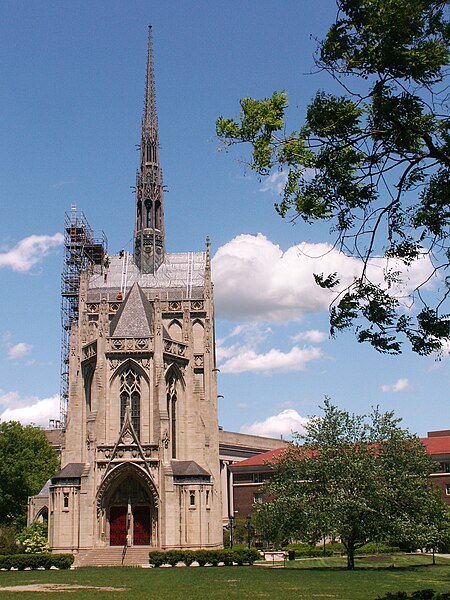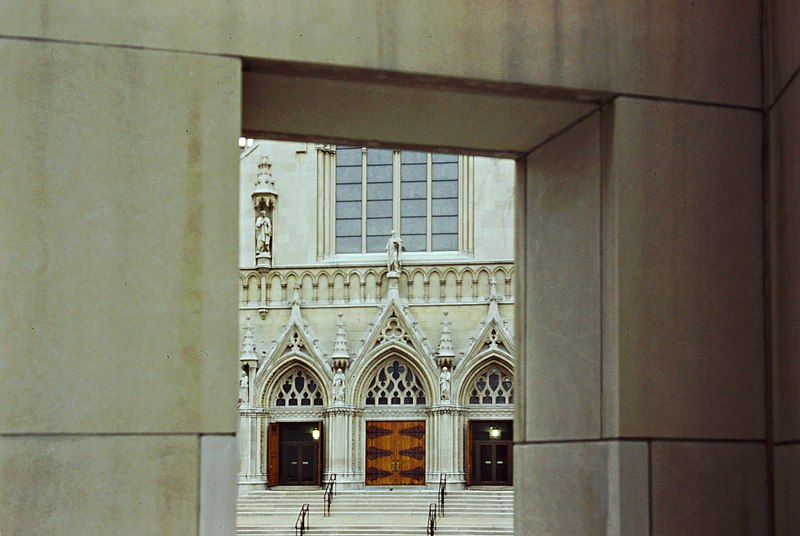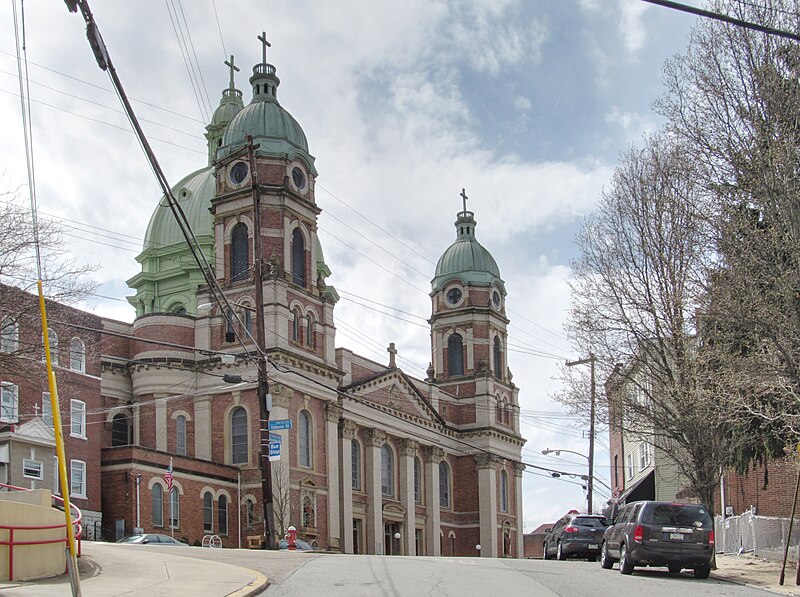
It’s easy to forget how tall Heinz Chapel is until we see people working on the roof.

 Now the Jerusalem Baptist Church, this church was built in 1864, according to the inscription on the front. The Pittsburgh History and Landmarks Foundation identifies the architects as Dahner and Dear.
Now the Jerusalem Baptist Church, this church was built in 1864, according to the inscription on the front. The Pittsburgh History and Landmarks Foundation identifies the architects as Dahner and Dear.
It is not possible to get a straightforward picture of this inscription without intrusive utility cables. Old Pa Pitt resorted to taking three different pictures from slightly different angles and welding them together, which was probably more work than it was worth. But here is a complete picture of the German inscription, and if drivers on Steuben Street were confused by the sight of a gentleman in eighteenth-century garb lying on the sidewalk pointing a long lens across the street, at least they had something to tell their families when they got home. “Deutsche Vereinigte Evangelische Kirche” is German for “German United Evangelical Church.”
As with many Pittsburgh buildings, the question “How tall is it?” cannot be answered without a paragraph of disquisition on topography. The precipitous Belgian-block street along this side of the church is Sanctus Street.
How should we describe the style of this church? The rounded arches might say Romanesque or classical, although a presentable Gothic building could be made simply by swapping them for pointed arches. We’ll call it classically Victorian.

This composition is no longer possible, because the building in the foreground was demolished to make way for the larger Rand Building that occupies the corner of Fifth and Craig today. At least old Pa Pitt is fairly sure he was standing in the old Mellon Bank building, although after almost three decades the memory clouds over a bit, and he had to rely on maps and angles to make that determination.

One of the many black stone buildings that still remained in Pittsburgh in the 1990s. Like almost all the others, Sixth Presbyterian has since been cleaned and restored to its original color.
Father Pitt has always wondered why the Presbyterians kept numbering their churches. “First Presbyterian” is an honorable distinction. “Fifth Presbyterian” just sounds tired. And then why stop at six? There is a Seventh Presbyterian in Cincinnati, for example. (Update: They did not stop at six; in fact both Presbyterian and United Presbyterian churches in Pittsburgh went into the double digits. Sixth Presbyterian is the highest number still going that we know of.)
Addendum: The architect was John Lewis Beatty; the church was built in 1902.1

If he had known that the church would be demolished the next year, Father Pitt would have been more careful to document it. As it is, he happened to be passing in 2001 with one of his many odd old cameras, and he decided to take this quick picture before rolling on. The architect was Frederick Sauer; the church was built in 1906.1
The church had been vacant for several years when the Sisters of Divine Providence demolished it and built a new Family Support Center. The front of that building bears a mural with a picture of St. Leo’s in it.

A fine example of the modest Arts-and-Crafts interpretation of Gothic that was fashionable for small churches in the early twentieth century. The building has hardly changed at all since it was put up in 1921, and it is still in use by the congregation that built it. The Community of Christ was formerly known as the Reorganized Church of Jesus Christ of Latter-Day Saints; it is a fairly liberal church that accepts but does not insist on the Book of Mormon as scripture and otherwise gets along better with mainstream Protestant denominations than it does with the much larger Church of Jesus Christ of Latter-Day Saints, which accounts for about 98% of Mormons.

Addendum: The architects were Carlisle & Sharrer, productive architects of small and medium-sized churches and houses for the upper middle classes.1

William P. Ginther, an Akron-based architect who also gave us St. Mary’s in McKees Rocks, designed this magnificent church, but much of the labor was done by the Polish railroad workers who formed the congregation. The design is inspired by St. Peter’s in Rome; this church isn’t quite on that scale, but it certainly dominates the neighborhood, and it would make a fine cathedral.



This neat little church was probably the first church to be built in the new neighborhood of Beechwood, which was later renamed Beechview when it was taken into the city of Pittsburgh. It has been well refurbished for a Spanish-speaking congregation. Some of the original stained glass is gone, and the tower is bricked in, but on the whole it looks much the way it looked more than a century ago. We also note the aggressive slopes for which Beechview is notorious.

Beechview itself was laid out in 1905, so this would have been one of the earliest buildings.

Beechview’s streets changed their names when the neighborhood entered the city, because Pittsburgh didn’t need yet another set of numbered streets. Sixth Avenue is now Methyl Street; Pennsylvania Avenue is now Hampshire Avenue.


Brereton Street was the commercial spine of Polish Hill. A few businesses still straggle along here, and the streetscape itself is one of those only-in-Pittsburgh sights: tall, narrow little buildings crowded on an improbably steep hillside, leading to a massive Renaissance church the size of a cathedral—Immaculate Heart of Mary.

